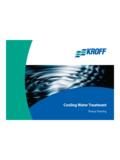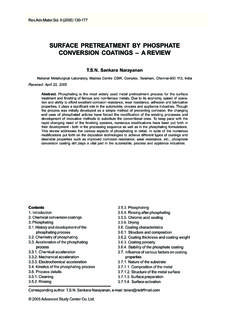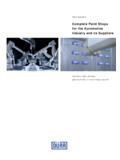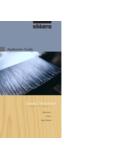Transcription of Boiler Overview - Kroff
1 Boiler Overview Steam is the basic energy transfer medium Uses include Residen7al and commercial hea7ng Plant process steam Plant power genera7on U7lity plant opera7on Cri7cal to the opera7on of the Boiler is water purity The components surrounding a typical Boiler system include the following: pretreatment (ion exchange, filtra7on) Dearator (combined with condensate return) Economizer (heat reuse) Steam management equipment (headers, traps) pretreatment Prepare the water to be boiled Calcium and magnesium salts are most insoluble in the hoHest areas Goal of pretreatment Minimize water use or wastage Minimize chemical use and reduce overall costs Common methods SoLening exchange hardness for less harmful ion Lime soLening precipitate hardness Filtra7on remove solids Demineraliza7on exchange all ions for H+& OH Reverse osmosis remove all ions to concentrate Softening Removes hardness in exchange for sodium Regenerate soLener with sodium chloride Hardness problems and consequences Iron fouling, organic fouling, poor regenera7on, poor control, damaged internals Increased deposi7on in Boiler .
2 Loss of heat transfer Zeolite SoLener Na * Resin Ca/Mg * Resin [Ca & Mg] * [SO42Cl 2 HCO3] [Na2SO4 2 NaCl 2 HCO3] Deaeration Based on Dalton s and Henry s Laws of gas solubility in water rela7ng to pressure and temperature. Deaeration Too much oxygen in the Boiler causes rust 4Fe3O4 (magne7te) + O2 6Fe2O3 (hema7te) Can remove this oxygen mechanically or chemically Mechanically Increase temperature driving off oxygen Increase surface area of water driving off oxygen Chemically Sulfite reacts with oxygen to make sulfate in water Organic acid, hydrazine, DEHA, hydroquinone Combina7on of mechanical and chemical means is typical Boiler System Firetube boilers Combus7on takes place inside tubes Water on shell side, must keep impuri7es from s7cking to the outside of the combus7on tubes Mud gravity seHles to boHom to be blown down, with steam out the top of the vessel Common packaged systems Watertube boilers Water on tube side, tubes consist of risers and downcomers.
3 Steam is on top in the steam drum, with deposits collected in boHom mud drum Several shapes and sizes exist Inspec7on Water Treatment Programs In a Boiler , mineral content in the remaining Boiler water is concentrated; ions do not evaporate Cycles of concentra7on Internal Boiler water treatment programs Precipita7ng programs Phosphate based programs (10Ca2+ 6PO42 + 2OH Ca10(OH)2(PO4)6) Analy7cal tes7ng procedures and review Solubilizing programs All polymer dispersant programs Analy7cal tes7ng procedures and review Chelant programs Analy7cal tes7ng procedures and review Condense Treatment Once steam is used, it is condensed and returned to the feedwater system The more returned the beHer Savings in make up water, because feedwater is composed of make up and condensate return Savings in heat, with condensate about 140 degrees hoHer than makeup, so for 1 lb of water, it takes 140 BTU of energy to get makeup to an equivalent temperature The carbon dioxide in steam condenses and can form carbonic acid, unless pH is controlled Neutralizing amines They condense in selec7ve loca7ons in the condensate system (near.)
4 Intermediate, and far) Testing Methods Analysis of impuri7es present in water Repor7ng quan77es Explana7on of parts per million Titra7ons Alkalinity, sulfite, hardness and chlorides Colorimetric Tests Phosphate, molybdates On line instrumental tests TDS/conduc7vity measurement/pH For surface blowdown and condensate Test Procedures Hardness Test SoLener & Condensate 1. Measure 100 mL of sample 2. Add 2 brass dipperful of Hardness Buffer Reagent (Code 291) and s7r 3. Add 1 brass dipperful of Hardness Indicator Reagent (Code 290) and s7r. If sample is blue, the water is soL 4. Add Hardness Titra7ng Solu7on drop by drop un7l color turns blue 5. Mul7ply bureHe reading by 10 to determine parts per million total hardness 6. Control at less than ppm Test Procedures Sulfite Test Boiler Water 1.
5 Measure 50 mL of sample 2. Add 4 drops of Phenolphthalein Indicator (Code 212) 3. Add 1 plas7c dipperful of Sulfite Indicator (Code 219) at a 7me and s7r between each addi7on. Con7nue addi7on un7l red color disappears, then add one addi7onal dipperful 4. Slowly add Potassium Iodide Iodate solu7on (Code 237). S7r constantly un7l a faint permanent blue color develops 5. Mul7ply bureHe reading by 10 to determine parts per million sulfite. 6. Control at 30 60 ppm sulfite Test Procedures Neutralized Conduc7vity Boiler Water 1. To 50 mL Boiler water, add 1 mL of Liquid Conduc7vity Reagent (Code 944) at a 7me and swirl to mix un7l colorless 2. Measure conduc7vity on Myron conduc7vity meter 3. Control at 4000 5000 umhos Test Procedures Orthophosphate Boiler Water 1.
6 Add 5 mL of filtered sample to mixing tube (Code 152) 2. Add Molybdate Reagent (Code 236) to second mark (15 mL) 3. Stopper and mix. Add one brass dipperful of Stannous Reagent (Code 239), stopper and mix well 4. Place mixing tube in viewing compartment, compare, and record result 5. Control at 30 60 ppm phosphate Test Procedures Hydroxyl Alkalinity Boiler Water 1. Fill mixing cylinder to 25 mL mark with Boiler water 2. Add 1 mL barium chloride solu7on, swirl to mix 3. Add 2 drops Phenolphthalein indicator, swirl to mix 4. Add sulfuric acid reagent one drop at a 7me, un7l color changes from pink to clear 5. Mul7ply number of drops 7mes 50 6. Control at 200 400 ppm (4 8 drops) hydroxyl alkalinity pH Condensate 1. Use pH meter, control at pH Safety Precautions Handling Boiler water treatment chemicals Sampling steam genera7ng systems Boiler water sampling High purity steam sampling Sampling quill explana7on Condensate sampling Cooling coil explana7on and discussion Boiler house safety concerns Analy7cal tes7ng precau7ons Reagent handling Handling precau7ons Review Quiz Why do we worry about hardness (calcium and magnesium) in the Boiler ?
7 What are the two ways that hardness is managed (in makeup and Boiler water)? What effect does oxygen have on the Boiler ? If makeup calcium is 1 ppm, and the Boiler is running at 20 cycles of concentra7on, how many ppm calcium is in the Boiler water? What two pieces of safety equipment should you have when handling chemicals?









